© 2019-2022 - All Rights Reserved
Here are some pictures from 2019. So you know there is all kinds of great stuff to see.
It's just that I can't get good photos of it. These are mostly point-and-shoot
documentation grab-shots. They are the photos used for the weekly breaks on the bird news page.
They are in reverse chronological order as used (last most recent at top-start; first
in Jan. at bottom-end). They were taken with a Canon Powershot SX40.
A couple more pics of two of the best birds of the fall...

American Woodcock, Utopia Park Dec. 4, 2019.
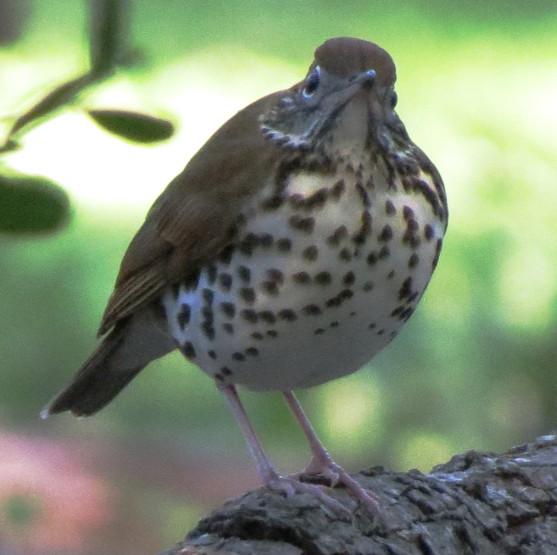
Wood Thrush, Utopia Park Oct. 25, 2019.

This is the imm. Zone-tailed Hawk wintering locally,
apparently roosting at the park (Dec. 11, 2019). I would
not be surprised if this is a locally hatched bird.
And now for just a little more squirming I wish I could see... ;)

This is a whole bird shot of the mystery bird posted three weeks ago.
Not the greatest on the head, but, the pic shows a definitive character
which absolutely proves the ID. Hint: the key definitive character
shown is the species specific epitaph.

American Woodcock at Utopia Park Dec 4, 2019
Hey Imma let you squirm another week on the mystery bird. Hope you don't mind.

This is a male Indigo Bunting, which I think is an adult in winter (basic) plumage. I don't think an imm. male in first fall can have this much blue below. But I am not sure, maybe a first fall bird can look like this? I never got to study these over a fall and winter to watch them change into blue. It is a pretty spiffy plumage, a blue-spotted bunting.

Here is a quiz bird. It jumped when I shot and the
head was cut off,
This was not intentional.
Prior, got a couple shots of the whole bird.
It is a
scarcely seen plumage so I thought maybe fun or interesting.

Behold! The great Mockerdini! Able to mimic other birds at a level fooling expert birders so well as to have had some bolt out of the house in just skivies and bins. This of course is the state bird of Texas, and several other states, a Northern Mockingbird. This might be what keeps you up at night singing in summer, those are mostly unmated males. Sometimes they will do this wing-flash to flush insects up out of the grass. This one was at the bird bath, so perhaps narcissistic. Actually I think this was likely a method of checking the water for hidden predators. Wing-flash it. Ten times. Finally it actually went to bath edge and drank.

This is a Mesquite Borer (Placosternus erythropus), one of the
Longhorn (Cerambycid) beetles. Methinks we are safe calling this
a bee mimic. I have seen them with bright red-orange legs.
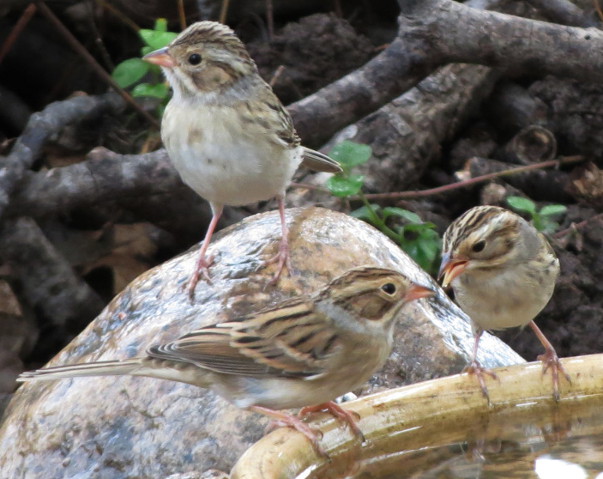
Clay-colored Sparrow, 2 adults, 1 imm. (front center facing right), one
adult explaining finer points of birdbath etiquette to the youngster.
Now you don't just jump in and splash all over the place...

Here is a docugrabshot of the Wood Thrush at Utopia Park
on Oct. 25. You take what you can get when a rarity.
Actually got some sharper, but shady without much rufous.
They are stunningly bright rusty above in the sun.

Black-throated Green Warbler at Lost Maples Oct. 13, 2019.
Missed the ID on the green something going down the hatch.

Long-billed Thrasher at the brush pile by the birdbath.
special hummingbird edition...

This is the Broad-tailed Hummingbird on Oct. 1, its last
day here (day 4). Note pale pastel peachy sides, bright
grassy green above, it has rufous in bases of outer tail
feathers you can't see here. Bigger than Ruby-throats,
with a neat soft chip call note. It was having a bad hair day,
we'd received a tenth of an inch, on its head apparently.

Here is the Ruby-throated Hummingbird being attacked by a
Praying Mantis (which appears the introduced non-native type).
I separated them (after grabbing photo - yeah I know, but...
must... get... docushot...), and the hummer flew off seemingly ok.

Male Ruby-throated Hummingbird, Sept. 12.
A little
over-exposed and burnt on the reflective part of gorget.

This is the immature American Redstart that visited the bath.
Did not get a good pic, but you get the idea. They flash the
wings and tail incessantly making themselves really quite showy.
a bonus piclet...

Here is a headshot crop... there are lots of Ruby-throated Hummingbird
passing through right now, most are pale throated immatures or females,
but fair numbers of adult males are present.

This is a juvenile Yellow-crowned Night-Heron, July 16
at
the fish hatchery at Uvalde. Not the one that flew over
calling
in the dark a few nights ago. Most that occur
here are juvenile
or immatures, adults are rarer here.

Mourning Warbler, male, September 12. I was trying to hide my
bloated carcass against front door, it was in adjacent flower bed.
another bonus pic...
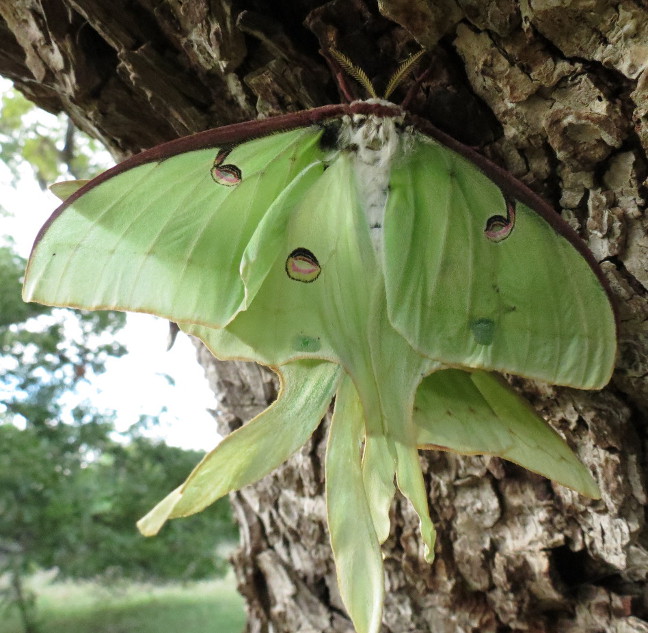
This is the mating pair of Luna Moth on Sept. 4. Was on the
big Pecan, they were there all day.
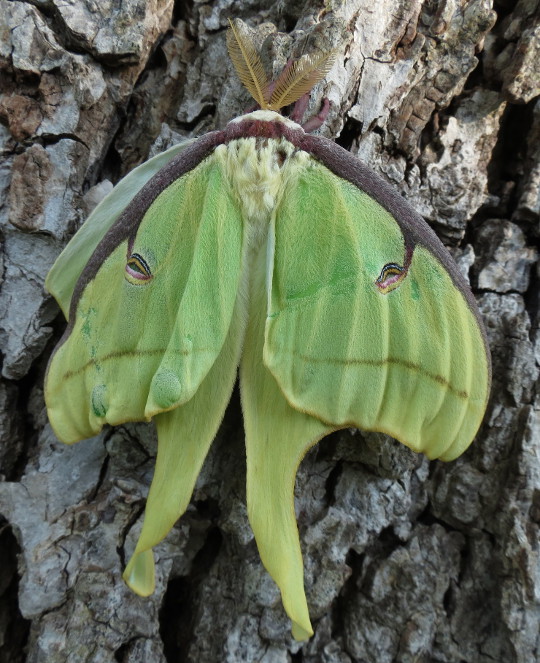
This is the Luna Moth pumping up and drying out just after
emerging from pupae on Sept. 2. They are 4.5" across!
and a mandatory bird pic
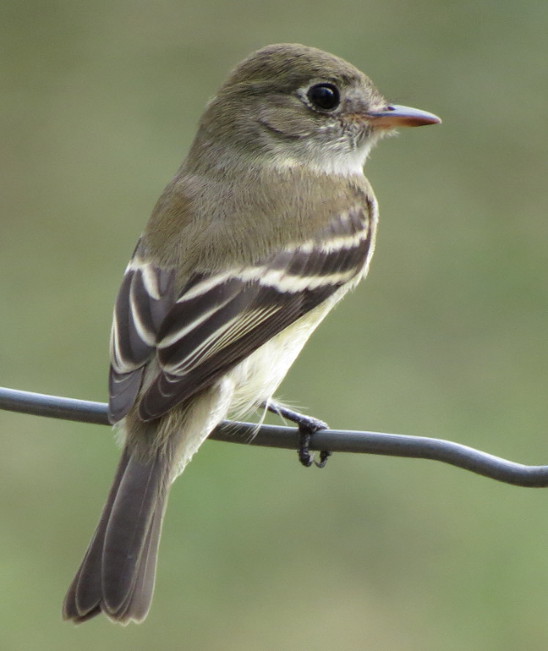
Here is the Least Flycatcher that was pigging out on termites as
they emerged after the rain, occasionally foraging from ground.
I had no idea you could fit that many termites in one of these.

Here is the Black-throated Green Warbler at the bath. They are the
cousins to our endemic breeding Golden-cheeked Warbler, but only occur here
as migrants passing through. Note the tinge of yellow at flank, which
continues around vent area between legs. All Black-throated greens show
this, Golden-cheeked are snow white throughout posterior underparts, always.

Here is the birdbath showing a little action. A milk jug over it
with pinholes provides a drip. On the left is an imm. Dickcissel,
on the right a male Wilson's Warbler, and 3 Yellow Warbler between.

Male Yellow Warbler at our bird bath. I am seeing 1-2 daily now
so they are on the move. Nothing like a drip to bring birds in,
works better than food, and they really need water in this heat.
The dark spots on the wing are shadows from water drops.
a bonus pic this week...

Here is a pic of the 'hummingbird hawkmoth', Sphinx moth
of the genus Aellopos, likely either clavipes or titan. Nectaring on
Snow-on-the-Mountain. They hover just like a hummingbird at flowers,
but often use front legs to steady themselves while feeding.

Male Orchard Oriole at our birdbath, there were several juveniles right
above him in the pecan. He went full submarine. It was early, dark and
overcast with very low light, had to use a high ISO and so a bit fuzzy
and dark, with apologies. One of the sharpest looking birds in America.

One last peek at a Golden-cheeked Warbler from this spring at Lost Maples SNA.
At this point, I will not likely to see another until next March.

Rufous Hummingbird, adult male, July 31. The iridescent gorget
feathers in throat usually appear an orangish red, but at some
light angles they can appear gold or green.

Blue-winged Teal (male, or drake) at Utopia Park April 7, 2019.

Bobwhite (female or hen), the second before she bursts into the air.

White-eyed Vireo, a rather messy one, perhaps an immature (iris is gray)
just molting from juvenile into first basic (winter) plumage.

Dobsonfly, female, on the fuel line at the gas station. Yes
they can draw blood. Larvae are aquatic, called Hellgrammites.
Wingspan is over 5 inches! This is probably Eastern Dobsonfly.
The obligitory bird photo, another head shot...

You looking for a bird photo here?

Red-tailed Hawk, our resident breeders are the fuertesi subspecies
of the southwest. They are very pale creamy white and barely marked
below, without the heavy belly band of Eastern Red-tails, and no dark
morphs of western Red-tails, but those types both occur here as winterers.
The black along leading edge of inner wing (patagium) is on almost all
Red-tails, and none of any confusing congeners show it.

Here is one of the big yellow bumblebees in flight.
And oh yeah, a male Painted Bunting.
No photoshop, one original frame.

Another pic of a female Mourning Warbler at Utopia Park.
Same individual as the one below. A perfectly quintessential
pose and view of the species. I suspect some central Texas
MacGillivray's reports are these Mournings with broken eye-rings.
Note the eyering is very thin, fine, and narrow, not thick.

American Pipit on May 10 in breeding plumage. This bird ducked
under the laid-down grasses and disappeared before my eyes.
Probably the plainest dullest bird you might see here. Note
the thin bill, not a thick-based seed-cracking sparrow type bill.
We do not normally get to see the buffy underparts of breeding plumage.

Dickcissel are numerous here this year after being absent last year.

Only a month or so left to see these here this year. I'm startin' to panic.
They can be fickle after mid-June. Often a few are around and findable to
mid-July. This past weekend we saw three sets of 2 fledglings being fed.

Here is the Wilson's Phalarope on May 11 in BanCo, at
the So. Little Crk. Rd. pond. Tough bird to get locally.

Mourning Warbler, female, Utopia Pk. May 11, 2019
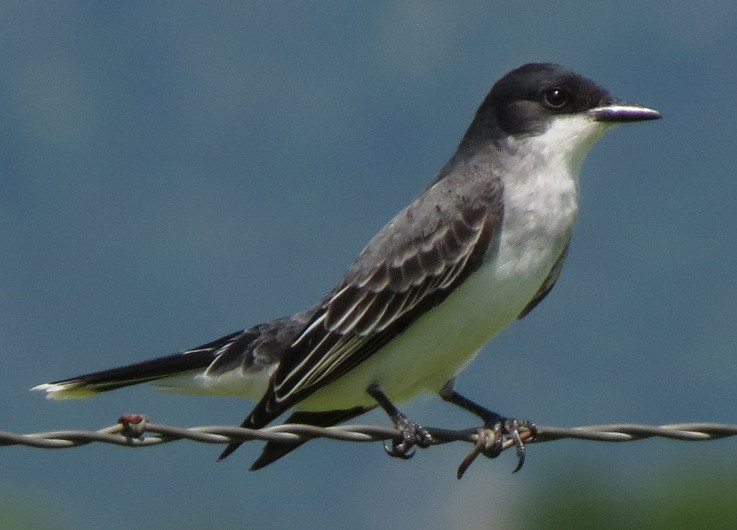
Eastern Kingbird - May 12 - Seven this spring is a good total, all were
on the fenceline a quarter+ mile south of town, where very few occur
annually in early May. Scissor-tails are fancy-tailed Kingbirds.
When you see long pointed wings, know you have a very good flier.

White-tipped Dove at Lost Maples. There are several pairs there spring
to fall the last few years with successful breeding occurring. This is in
Bandera Co. at 1800', on the Edwards Plateau! Methinks the furthest
north known nesting station, and probably only known on the plateau.
Pretty for its mastery of sombre subtlety, with which they can disappear
in the shadows like you wouldn't believe.

Male Indigo Bunting

Grasshopper Sparrow, April 7, just NW of town,
from car with cheap crappy equipment.

Golden-cheeked Warbler, male

A female Golden-cheeked Warbler, note green back
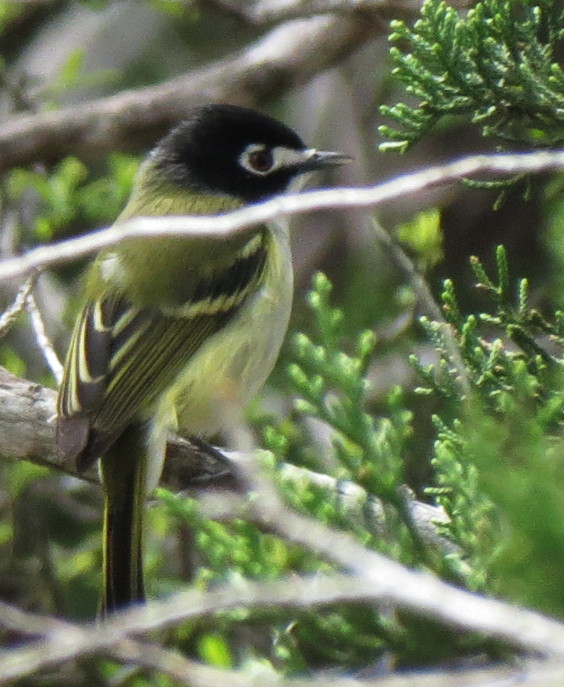
Black-capped Vireo.
Note gray nape, not completely black.
This is another third year male, still without fully black head.
Second year male head is mostly gray like females, but have a
few black flecks and small patches of a few black feathers
here and there when return the first time. Definitive
(fully mature) adults have fully black heads with no gray.
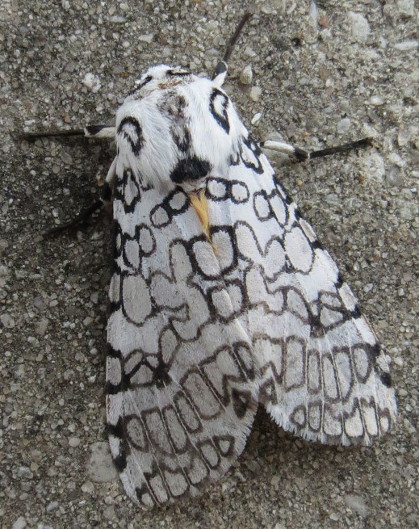
There were a bunch of these moths on the ground at the P.O. today.

This is the Couch's Kingbird, that the Western KB was with
down in Sabinal in January. Note how saturated the yellow is
and how it reaches up the breast to the green upper breast.
Nicely notched tail, a bit of the dark mask is visible behind eye.

Here is a pair of Wood Duck, sorry for the wee bit fuzzy.

This is maybe 20% of the mega flock of Amercian Goldfinch we saw just north of Sabinal Jan. 27. There are a hundred birds in this frame. At times the flock stretched a quarter mile, all like this. It was a cloud of them, working a ploughed field that had a giant sunflower crop this year.

A classic sign of spring is migrating geese heading north.
We virtually never see White-fronted Goose on the ground here,
but they are regular spring migrants overhead a thousand feet up.
Often at night, which tends to make photographing them tricky. :)
Early to mid-morning you can catch them if lucky. This is how we
usually see them here, flying high overhead. I have a genetic defect
which allows me to hear them when I look at pictures of them.



Henry's Elfin, is a nickel-sized little beauty and one of the first new butterflies to fly in spring. Elfins are an odd group in the Hairstreak family. I could not catch the extent of the purple haze (overscaling) in the photo, they are really maroonish in areas when fresh. Their flight season is over and they are done flying for the year by mid-April here, only about eight weeks total as a flying adult. Larval foodplants are Spanish Buckeye and Redbud, and maybe Agarita. They are usually found on one of those, as on this Agarita.
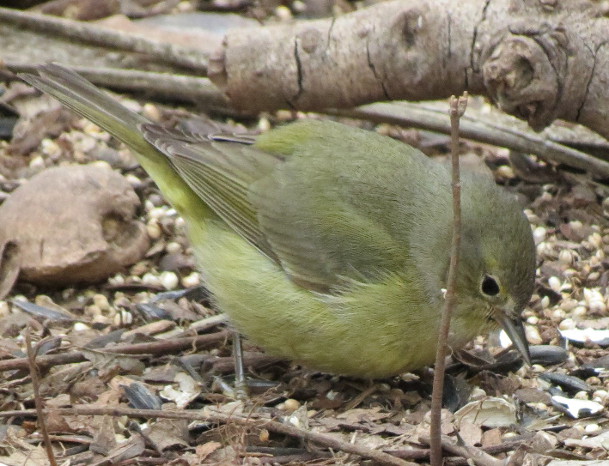
Orange-crowned Warbler foraging for millet during a freeze.
Some birds are named after a part you are least likely to see.
Primarily these are dead leaf cluster specialists, masters at picking
out bugs or whatnot that was trying to over-winter wrapped in a dead leaf.
General color scheme recalls female or imm. Painted Bunting.
Bill structure is key to placing birds in right family group. Note the longer
thinner spiky warbler type bill, not a thick short deep-based seed cracking beak.

Here is another pic of the Wilson's Warbler wintering at Utopia Park
(and somewhere closeby in the vicinity), Dec. 14 through Jan. 26 (this pic).
Note orange lores and forehead.
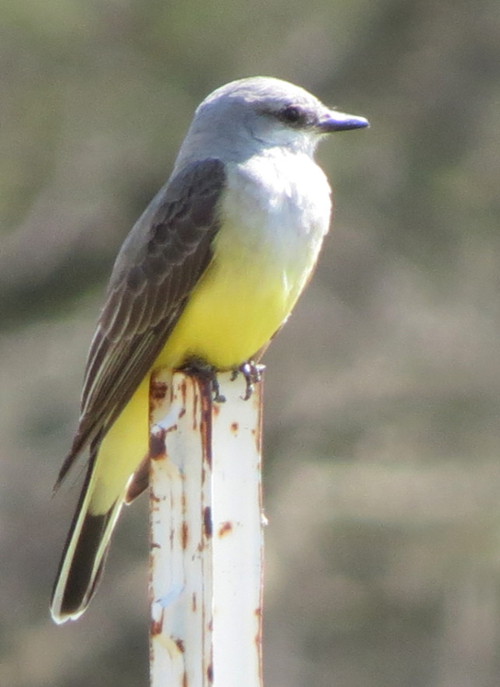
This is the Western Kingbird in Sabinal, Jan. 27. The snow white
outer webs on the outer tail feathers are diagnostic. This is a
supermega rarity in winter in Texas.
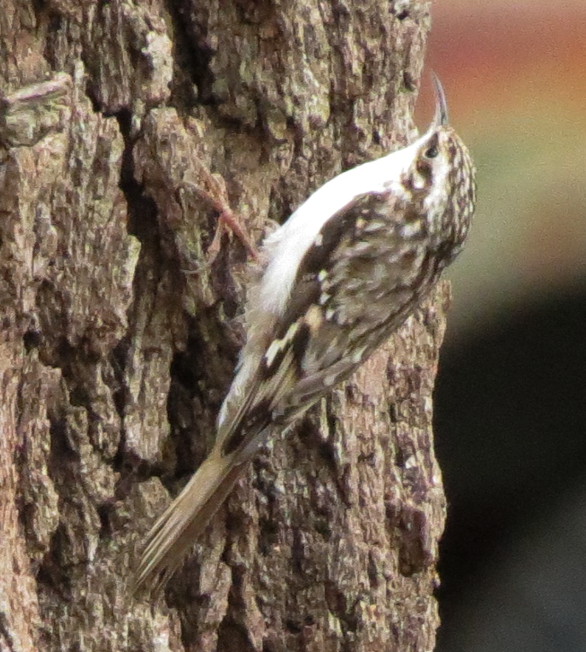
This is the Brown Creeper that has been wintering at the park,
finally a docushot after two months of visits. My what big
strong feet you have.

Golden-crowned Kinglet, just hangin' around
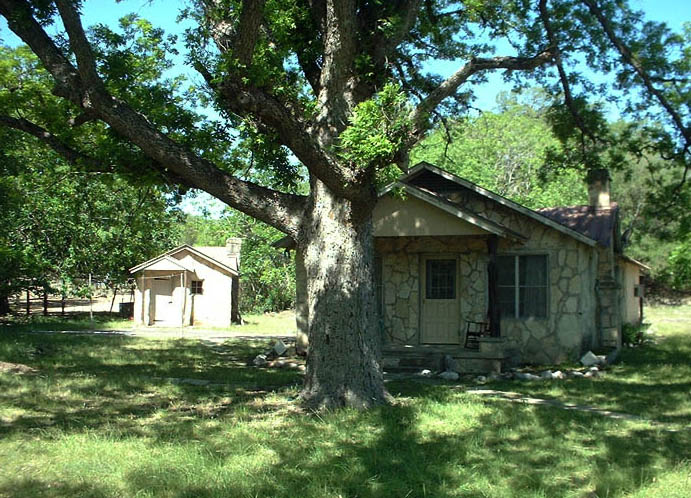
Just to give an idea, here is a pic showing part of the yard, house and cottage, so you can get an idea of where much of the stuff being written about is being seen. This pic was May 2013, barely two months after we moved into this place. Now there are butterfly flowers around the porch. Yard lists are: about 40 species of odes (dragons), over 85 sps. of butterflies, 7 sps. of frogs & toads, 7 sps. of native lizards, 20 sps. of native mammals, about 100 sps. of plants (mostly wildflowers), and at the 6 year point, about 220+ species of birds.
Quick links to the last few years ...
2015 pix
2016 pix
2017 pix
2018 pix
2020 pix
2021 pix
2022 pix
If you have arrived here from our Bird Photos page, you may close your browser to return to the Bird Photos index.
Other visitors may click your "Back" button on your browser or select a link to keep visiting!
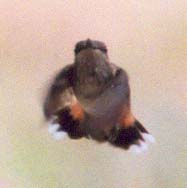
To Bird Photo Main Menu
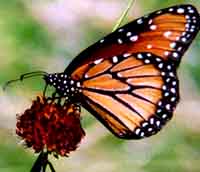
To Butterfly Pics
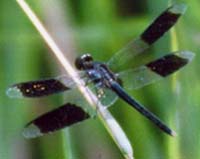
To Dragonfly & Damselfly Pics
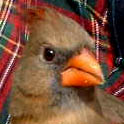
To Current Bird News
Birds
Utopia Birds
Birding Sites
Bird List
Bird Guide
Reports from Lost Maples
Winter Bird Count
Butterflies
Butterfly News
Butterfly List
Butterfly Photos
Rare Butterflies
Dragonflies
Critters, Bugs, & Stuff
Lost Maples
Garner State Park
Local Site Guide
Home
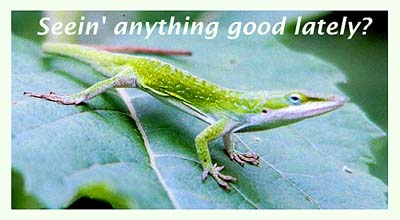
Our E-mail
mitch @ utopianature.com
 All photographs within this site are copyrighted
All photographs within this site are copyrighted